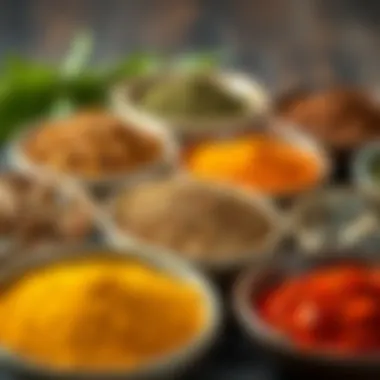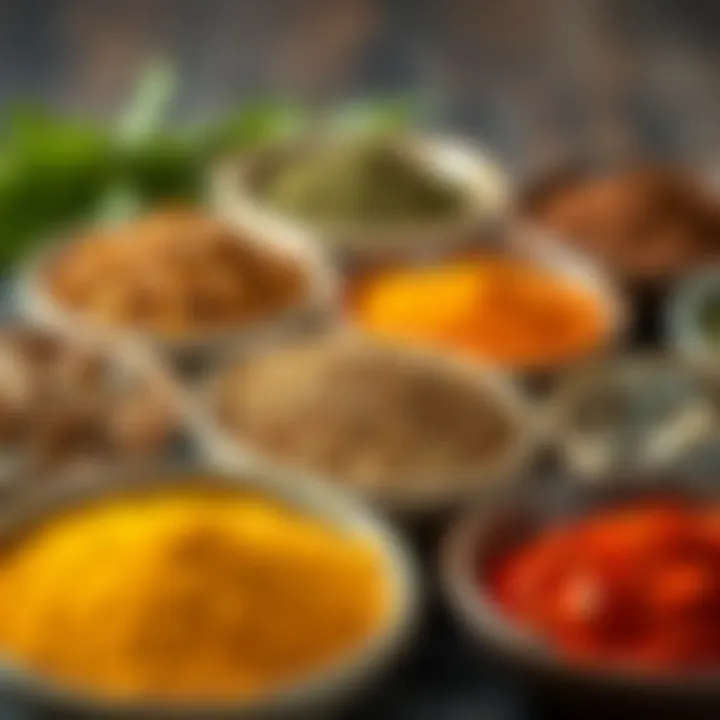Enhance Your Meals with Low Sodium Herbs and Spices


Intro
In a world where taste and health often seem to be at odds, the quest for delicious meals that also support wellness is more relevant than ever. Many people are attempting to lower their sodium intake for various reasons—be it managing high blood pressure, enhancing heart health, or simply adopting a more balanced diet. The good news is that nature provides an abundance of low sodium herbs and spices to dress up your dishes, allowing you to savor full flavors without the excess salt.
Imagine fresh basil sprinkled atop your pasta or a dash of cumin giving depth to a vegetable stew. These culinary gems not only kick your meals up a notch but also bring a wealth of health benefits. In this article, we’ll delve into a variety of herbs and spices that fit the bill, how to incorporate them into your cooking, and even a few tips for making savory substitutes for traditional salt.
As we explore these natural flavor enhancers, whether you’re a seasoned home cook or a curious food lover, prepare to discover many new opportunities to shake up your culinary routine—without compromising your health.
Prolusion to Low Sodium Cooking
Low sodium cooking has surfaced as essential in today’s culinary landscape, where health and flavor need not be mutually exclusive. The phrase "low sodium" often conjures up thoughts of bland, tasteless meals. However, this could not be further from the truth. Shifting toward a low sodium lifestyle doesn’t mean sacrificing enjoyment at the dining table; rather, it opens up a treasure trove of flavors waiting to be explored.
The need for low sodium options has risen due to the increase in health concerns associated with consuming excessive salt, such as hypertension and heart disease. For many, switching to a low sodium diet means revisiting age-old family recipes or trying new ones that utilize the richness of herbs and spices in place of salt. Packed with flavor and nutrition, these alternatives magnetize our taste buds while keeping health risks at bay.
To embrace this cooking style, one must dive into the world of herbs and spices. Not only do they offer a plethora of flavors, they also come bearing multiple health benefits. Understanding different herbs and spices can make all the difference in creating meals that are not just edible, but exquisite. As this article unfolds, it will illuminate the significance of savvy seasoning choices, teaching the art of enhancing flavor profiles without reaching for the salt.
"Cooking with low sodium doesn’t restrict flavor; it liberates your palate to discover nature's rich bounty."
Understanding Low Sodium Diets
At the core of low sodium cooking is a clear comprehension of low sodium diets themselves. Sodium is a mineral crucial for body functions, but too much of it can lead to various health issues. Essentially, a low sodium diet suggests a daily intake lower than 2,300 milligrams, which is the general recommendation. For certain individuals, especially those with specific health conditions, that number can be even lower.
Transitioning into a low sodium routine involves a shift not only in cooking but also in shopping habits. Familiarizing oneself with food labels to avoid hidden sodium in processed foods is key. Many people are surprised to find that ingredients such as breads, sauces, and even some dairy products can pack a salty punch. By consciously choosing fresh, minimally processed ingredients, one can significantly cut their sodium intake while still enjoying delicious meals.
The Importance of Flavorful Alternatives
With the notion of reducing salt, many might wonder: how does one keep flavor afloat? Enter the colorful and aromatic world of herbs and spices. These natural flavor enhancers can turn a simple dish into a culinary masterpiece. Consider the appeal of fresh basil in a caprese salad or the warmth cumin brings to lentil soup.
Low sodium alternatives, when used wisely, can not only replace salt, they can elevate dishes to new heights. Experimenting with combinations and understanding how to layer flavors become essential skills in this culinary journey. Choosing acidic elements like lemon juice or vinegar can brighten a dish while herbs like dill and cilantro lend their unique zest, crafting complexity within every bite.
Delving into the varieties and attributes of low sodium herbs and spices through this article, readers will uncover how to harness their potential in everyday cooking. Through thoughtful choices, you can leave sodium behind while embarking on a flavorful adventure that nourishes both body and soul.
Herbs and Spices Defined
When we delve into cooking, herbs and spices serve as the cornerstones of flavor. Understanding what distinguishes them is crucial, especially for those who are nurturing a low sodium lifestyle. Herbs typically come from the leafy green parts of plants and are often used fresh. Think of basil or cilantro—these add brightness to a dish. Spices, on the other hand, are derived from various other parts of plants: roots, seeds, and bark. Examples include cumin and cinnamon, which bring warmth and depth.
Differences Between Herbs and Spices
The distinction isn’t just botanical; it affects culinary applications. Herbs are usually added toward the end of cooking. This preserves their delicate flavors and nutritional profiles. For instance, adding fresh thyme to a stew right at the end will yield a fresh, vibrant taste. In contrast, spices benefit from longer cooking times. They release their essential oils gradually, which can enhance the overall flavor profile of a meal. Think of roasting spices like cumin or coriander in oil to bring out their richness before adding them to a dish.
In terms of health benefits, both herbs and spices pack a mighty punch. Herbs often carry high levels of vitamins and antioxidants. In fact, certain herbs can act as natural anti-inflammatories. Spices, on the other hand, can offer benefits ranging from improving digestion to balancing blood sugar levels. For example, turmeric is celebrated for its anti-inflammatory properties—with its golden hue brightening both dishes and health.
Common Characteristics and Uses
Herbs and spices share common ground by enhancing flavor and nutritional value in various dishes. Both can transform an ordinary meal into something extraordinary without the need for excessive salt. Aside from their flavor-enhancing qualities, they also contribute vibrant color and aroma. Here’s a succinct rundown of their key roles:
- Flavor Enhancement: Whether used in marinades, soups, or as garnishes, they enhance the taste profile of dishes.
- Aroma Contribution: They play a key role in appealing to our senses, often making meals more inviting.
- Nutritional Benefits: Added health benefits such as antioxidants and vitamins make them a great addition to any diet.
Their versatility means you can sprinkle dried oregano on a pizza or toss fresh parsley in a salad. It's this flexibility that allows them to fit into any meal, whether breakfast, lunch, or dinner. Simple yet effective, they are the unsung heroes in the kitchen, often overlooked but immensely vital for both health and flavor.
"A sprinkle of herbs or a dash of spices can turn a simple dish into a culinary masterpiece."
Health Benefits of Low Sodium Herbs and Spices
In today's health-conscious world, the significance of maintaining a balanced diet has never been more crucial. Low sodium herbs and spices are not only essential for enhancing flavor but also come with a slew of health benefits that can positively impact our well-being. Understanding these benefits is fundamental for anyone looking to reduce salt intake without sacrificing taste. They play a vital role in cooking and have a lasting effect on our overall health.
Nutritional Contributions
Many herbs and spices are packed with nutrients, offering far more than just flavor. They are often rich in vitamins, minerals, and antioxidants. For instance, rosemary is noted for its high antioxidant properties which help combat oxidative stress in the body. Similarly, basil provides not only taste but also vitamins A, K, and C, which contribute to maintaining healthy skin and a robust immune system. By integrating such herbs into our meals, we can elevate the nutritional value of our dishes effortlessly.
Some of the key nutritional benefits include:


- Antioxidants: They help neutralize free radicals, thus reducing the risk of chronic diseases.
- Vitamins: Essential nutrients like C and K not only support bodily functions but also promote good health.
- Minerals: Herbs like thyme contain important minerals like iron and manganese, which are helpful in numerous bodily processes.
Utilizing low sodium herbs and spices offers numerous possibilities for nutrient-dense meals. Keeping one’s health in mind while experimenting with different herbs can pave the way for healthier eating habits, helping both culinary creativity and health-driven choices.
Impact on Blood Pressure and Health
The fight against high blood pressure is increasingly relevant, and adopting low sodium herbs and spices can serve as a strategic approach. Salty flavoring can be a hidden culprit in elevating blood pressure, leading to various health issues. By replacing salt with flavorful herbs and spices, individuals can maintain taste in their meals without the associated health risks of high sodium intake.
Research suggests that certain herbs and spices, such as garlic and turmeric, may actively lower blood pressure. Garlic, in particular, contains compounds that help improve blood circulation, whereas turmeric has anti-inflammatory properties that can guard against heart disease.
"Replacing salt with herbs isn't just about cutting back; it's about enhancing flavor while nurturing your body's health."
By utilizing low sodium alternatives, one can experience a broader spectrum of flavors that begs to be explored rather than restricted to high-sodium options. This not only impacts blood pressure control but also fosters overall cardiovascular health, creating a win-win situation for enthusiasts of good cooking and healthy living.
Top Low Sodium Herbs
Incorporating various herbs into your cooking can transform bland meals into something lively and scrumptious without any major sodium concerns. Utilizing low sodium herbs not only enhances flavor but also offers a plethora of health benefits. They should feature prominently in your culinary arsenal. The ability to season effectively while adhering to a low sodium diet is vital for those seeking to maintain or improve their health. Not to mention, the way herbs bring vibrancy to your dishes caters to both the palate and the eye, making each meal a feast.
Basil: A Versatile Favorite
Basil stands out as a prime example of how a simple herb can work wonders. Known for its sweet, fragrant notes, it is widely used in a range of cuisines, from Italian to Thai. The flavor of basil can elevate dishes such as pasta sauces, salads, and sandwiches, making them sing. You should choose fresh basil whenever possible for the best impact—dried leaves, while good, do not possess the same zest and aroma.
How to use it: Finely chop fresh basil and toss it into your pasta salad or sprinkle over tomato slices for an irresistible Caprese salad. Additionally, blending basil with olive oil for a quick pesto is an easy way to add a whole new dimension to your meals without any excessive sodium.
Oregano: The Mediterranean Touch
Oregano is the flavor backbone of many Mediterranean cuisines. Its earthy yet slightly bitter notes make it perfect for seasoning meats, sauces, and veggies. It’s packed with antioxidants and has been recognized in various studies for its potential health benefits, including anti-inflammatory properties.
Using oregano properly can elevate your cooking. Toss it into marinades for meats or stir it into tomato sauce for a pizza that packs a punch. You might even dry fresh oregano and create your own spice mix, giving your dishes a delightful lift and vibrant aroma.
Rosemary: Earthy and Robust
Rosemary brings a robust flavor and earthy quality that can stand up to heartier dishes. Known for its needle-like leaves, rosemary’s flavor profile is distinctive and a little piney, making it great for roasting meats and vegetables. Its aroma can also be quite invigorating.
You can enhance your classic roasted potatoes or vegetables by adding fresh sprigs of rosemary. Infusing olive oil with rosemary doubles as a tasty salad dressing and flavor enhancer for dipping bread.
Thyme: Subtle yet Striking
Thyme may not be the loudest herb in the kitchen, but its subtle nuances add dimension to a variety of dishes. It pairs seamlessly with meats, soups, and sauces, balancing flavors without overpowering them. It’s also a hero when it comes to complementing vegetables.
A good way to make use of thyme is to toss fresh leaves into stews or slow cooker recipes. Its delicate fragrance develops beautifully when simmering, leaving a lasting impression on the dish.
In summary, incorporating these top low sodium herbs into your everyday cooking can not only cut down on salt but also enhance the overall dining experience. Each herb carries its unique qualities that can cater to numerous palettes, facilitating a culinary journey through texture and taste.
Notable Low Sodium Spices
In the realm of flavor, spices reign supreme. They can elevate a dish from ordinary to extraordinary, especially for those on a low sodium regimen. Low sodium spices not only help to amplify the taste of meals but also offer numerous health benefits. Understanding which spices to incorporate can be vital for anyone looking to maintain a flavorful diet without an excessive sodium intake. Let’s delve into some of the most notable low sodium spices and their unique characteristics.
Cumin: Warm and Nutty
Cumin brings a cozy warmth to dishes, making it a cornerstone in many culinary traditions, particularly in Indian and Mexican cuisine. This spice has a nutty, earthy flavor that enhances the profile of a meal without the need for salt. Cumin seeds can be used whole or ground, allowing for flexibility in cooking methods.
Health-wise, cumin is noted for its potential digestive benefits and for being rich in iron, which can be an advantage for those looking to maintain their overall wellbeing. Adding cumin to roasted vegetables or stirring it into soups can dramatically improve flavor depth while keeping sodium levels in check.
Paprika: Sweet and Smoky
Paprika brings not just color but also a delightful taste to dishes. This spice, made from ground peppers, comes in several varieties—sweet, smoked, or hot. The sweet variety is particularly adept at enhancing flavors without being overpowering, while smoked paprika delivers a rich, deep essence that can replace the umami notes typically sought through salt.
Incorporating paprika into recipes such as stews, rubs for proteins, or even sprinkled atop popcorn offers a flavorful alternative that keeps sodium concerns at bay. Its visual appeal also adds a vibrant touch to your plate, making meals not just taste good but look good too.
Turmeric: Bright and Healing
Turmeric is often regarded as a super spice, not only for its flavor but also for its myriad health benefits. Known for its bright yellow hue, this spice carries a warm, peppery flavor that serves as a perfect enhancer for many dishes. Its active ingredient, curcumin, is celebrated for its anti-inflammatory properties, which makes turmeric an excellent addition for those focusing on health.


From curries to rice dishes and even smoothies, the adaptability of turmeric shines through. A pinch can transform a mundane meal into something noteworthy, all while ensuring a low sodium intake.
Black Pepper: The Universal Spice
No spice cabinet is complete without black pepper. Often referred to as the "universal spice," black pepper offers a sharp bite and can enhance nearly any dish. Its versatility makes it a go-to for chefs and home cooks alike. The added benefit of black pepper lies in its ability to increase the bioavailability of certain nutrients, which can be advantageous for overall health.
Simply grinding fresh black pepper over salads, meats, or pastas can provide an extra punch of flavor without relying on salt. Its wide availability and ease of use make it a staple spice for anyone aiming for a healthier kitchen.
The essence of cooking lies not only in the ingredients but in how they interact on the palate. Low sodium spices like cumin, paprika, turmeric, and black pepper can redefine how we perceive flavor while honoring our health.
Incorporating a variety of low sodium spices into your cooking routine doesn’t have to be a daunting task. By learning about the unique properties and health benefits of these spices, you can take your culinary skills to new heights while keeping sodium in check. Consider experimenting with different combinations to discover your own flavor profiles.
Combining Herbs and Spices
Combining herbs and spices is not merely an art; it's a vital culinary practice that transforms ordinary dishes into memorable experiences. Understanding how to blend these flavors is fundamental for anyone looking to enhance their cooking, especially when aiming to keep sodium intake low. Together, herbs and spices can create complex flavor profiles that rival the taste of salt-laden dishes.
Creating Flavor Profiles
Crafting unique flavor profiles involves blending various herbs and spices that complement each other. Consider the examination of taste as a palette. Each herb and spice contributes its unique hue, creating an image of flavor on the plate. A dash of thyme might introduce an earthy note, while the warm embrace of cumin could add depth. Here are some considerations for building these profiles:
- Pair Sweet with Savory: A touch of cinnamon can offset the savory notes of garlic and onion in many dishes.
- Use Color as a Guide: Bright herbs like parsley or cilantro not only add color but also lift other flavors.
- Balance is Key: A pinch of a zesty spice can provide contrast, allowing other flavors to shine.
Incorporating these elements leads to delicious dishes that excite the palate. Here are a few combinations to get you started:
- Mediterranean Blend: Oregano, basil, and garlic powder create a refreshing taste ideal for pasta sauces.
- Mexican Medley: Cumin, coriander, and chili powder bring a kick to roasted vegetables or beans.
- Herbaceous Delight: Rosemary, parsley, and lemon zest can elevate roasted chicken or fish to new heights.
Regional Blends and Seasoning Mixes
Each culture possesses unique blends that reflect its culinary history and preferences. These regional blends are a treasure trove of flavor that can simplify the cooking process while making meals drastically better. For instance:
- Ras el Hanout: This Moroccan blend often includes cinnamon, nutmeg, and cardamom, great for tagines or stews.
- Herbes de Provence: A classic French mix with lavender, savory, and thyme, ideal for roasted meats and vegetables.
- Garam Masala: An Indian mix featuring coriander, cardamom, and cloves, perfect for curries or lentil dishes.
When using these blends, it's essential to respect their potency. A little goes a long way, so trial and error may be necessary for achieving the best flavor without overpowering the dish.
As you explore the world of herbs and spices, remember that the goal is not just to remove salt from your diet, but to discover the vast canvas of flavors it can provide.
Combining different herbs and spices not only makes your dishes flavorful, but it also adds an extra layer of healthfulness, leading you towards meals that are both enjoyable and nourishing. Each blend tells a story of its origin, making your culinary journey even more enriching.
Practical Applications in Cooking
Cooking with low sodium herbs and spices isn't just about flavor; it's a practical approach that shapes how we connect to our meals. Understanding these applications can significantly transform your culinary experience, making it both healthier and tastier without the need for excessive salt. The right herbs and spices serve as powerful allies in your kitchen, infusing dishes with richness and depth.
Utilizing low sodium seasonings allows for a more mindful cooking process. Instead of solely relying on salt to boost flavor, cooks can explore a vast array of natural herbs and spices that not only enhance the taste but also contribute health benefits. This exploration is especially crucial for those watching their sodium intake, but it goes beyond mere necessity; it paves the way for an exciting culinary adventure.
Marinades and Dressings
A well-crafted marinade is like a warm hug for your groceries, enveloping them in flavor. Low sodium marinades can be a game-changer for meats, seafood, and even vegetables. A simple blend of herbs like rosemary and thyme, combined with a splash of vinegar or citrus juice, can create a flavorful embrace without bringing sodium along for the ride.
When preparing dressings, consider blending herbs such as basil or cilantro with olive oil, mustard, and lemon juice. This combination coats salads in a refreshing, zesty flavor, complementing the natural tastes of your greens without the added sodium.
- Key Benefits of Marinades:
- Tenderizes proteins, making them juicy.
- Can be prepared in advance, saving time.
- Allows experimentation with various tastes.
Seasoning Roasted and Grilled Foods
Roasting and grilling are perfect platforms for unleashing the powerful flavors of low sodium herbs and spices. Whether it’s ribeye steaks or a medley of seasonal veggies, these cooking methods work wonders for drawing out natural sugars, creating caramelization.
Sprinkle some oregano and paprika on your roasted potatoes for a smokey finish; or mix cumin with coriander to add warmth to grilled chicken. The beauty of seasoning roasted and grilled foods lies in its simplicity—just a few herbs can radically transform a dish, making it sing with flavor.
- Considerations When Cooking:


- Apply dry herbs early in the cooking process.
- Use fresh herbs towards the end to preserve their potency.
Enhancing Soups and Stews
Soups and stews are arguably the heart of comforting home cooking. Low sodium options here don't just replace flavor, they amplify it. Start with a robust base—like a homemade broth infused with garlic, bay leaves, and paprika—and you'll find the richness transcends any dish. Adding herbs such as parsley, thyme, or bay leaves during the simmering process allows these flavors to meld beautifully together.
Using different spices can add complex notes as well—incorporate a dash of turmeric for earthiness, or black pepper for heat. The goal is to build layers of flavor that make every spoonful satisfying without relying on salt.
- Tips to Boost Flavor in Soups:
- Start with sautéing onions and garlic in a bit of oil.
- Taste and adjust seasonings as you go, ensuring a balanced profile.
Tips for Storing Herbs and Spices
Proper storage of herbs and spices is essential for preserving their fresh flavors and beneficial properties, particularly when you’re steering towards a low sodium lifestyle. The vibrant hues and aromatic scents of your herbs and spices can fade faster than you might think. When you understand how to store them correctly, you not only extend their shelf life but also maximize the flavors they bring to your dishes. This section dives into optimal drying and preservation techniques, as well as tips to maintain their freshness, ensuring you can enjoy lively flavors without the need for excess salt.
Drying and Preserving Methods
Drying is one of the most common and effective methods for preserving herbs at home. It helps concentrate their flavors, making them a powerful ally for any cook, especially those looking to reduce sodium, because it allows for intense flavor boosts without adding salt.
Here are some methods for drying herbs that you might find handy:
- Air Drying: Simply hang the herbs in small bundles upside down in a cool, dry place, away from sunlight. This way they're kept out of the heat, which can degrade flavor.
- Oven Drying: If the weather’s not cooperating, you can dry your herbs in the oven. Spread a single layer of herbs on a baking sheet and place them in a preheated oven at the lowest setting (around 180°F or 82°C). Keep an eye on them; it usually takes less than 30 minutes.
- Dehydrator: A dedicated food dehydrator can also do the job effectively and often is the quickest option.
"Proper drying techniques are vital to lock in the flavor of herbs, which can enhance any dish without compromising on health."
Proper Storage to Maintain Freshness
Storing your dried herbs and spices properly is just as critical as the drying process itself. Once dried, it’s important to shield them from factors that can reduce their potency, like moisture, light, and heat. Here’s how to go about it:
- Use Airtight Containers: Glass jars with tight-fitting lids or dark-colored bottles are great choices. They will keep out moisture and protect herbs from light.
- Label Your Containers: Knowing what’s what can save a lot of hassle. Don’t forget to include the drying date; this helps track freshness.
- Keep Them in a Cool, Dark Place: Storing your herbs in a pantry or cupboard, away from the stove and any heat sources, is generally the best bet.
- Avoid the Fridge: Although it may seem logical, the moisture from the fridge can lead to mold and spoilage of your dried herbs.
By following these tips, you’ll safeguard the vibrant flavors and health benefits of your herbs and spices. This storage knowledge empowers you to take full advantage of the culinary potential of low sodium cooking, allowing you to season your meals to perfection all while keeping health in focus.
Low Sodium Substitutes for Common Seasonings
In the world of cooking, sodium is often synonymous with flavor. For individuals keen on lowering their salt intake, this can pose a challenge. However, the way we think about flavor can change, especially when it comes to seasoning our meals. Understanding low sodium substitutes for common seasonings opens up a treasure trove of culinary possibilities that don’t compromise on taste. In this section, we will explore how to replace traditional seasonings effectively and enhance the taste of dishes while safeguarding your health.
Replacements for Salt in Recipes
Salt is a double-edged sword; it adds flavor but also contributes significantly to sodium intake. The culinary world is rich with alternatives that can satiate the palate without the sodium punch.
- Herb Blends: Italian seasoning or a homemade blend of herbs like oregano, basil, and thyme can add a lovely depth to dishes.
- Garlic and Onion Powder: These are powerful flavor boosters. They bring warmth and richness that can make up for the lack of salt.
- Nutritional Yeast: This can bring a cheesy flavor to dishes, making it an ideal substitute in pasta or popcorn.
- Sea Vegetables: Incorporating dried seaweed, such as dulse or nori, can impart a unique umami flavor that can often replace the salinity of salt.
- Smoked Paprika: For those looking for a hint of smokiness, this spice not only adds a beautiful color but a savory depth too.
Remember, when replacing salt, it’s essential to adjust gradually. Too much of a good thing can overwhelm the dish. Start with small amounts and taste as you go.
Using Acids for Flavor Enhancement
Acids can be a game-changer in the low sodium cooking sphere. They zest things up, brighten flavors, and can make food come alive. Using acids doesn’t just replace the need for salt; they enhance natural flavors in a remarkable way.
- Citrus Juices: Lemon, lime, or orange juice can enliven any dish. A spritz of lemon juice on grilled vegetables, for instance, can take the dish from ordinary to extraordinary.
- Vinegars: Balsamic, apple cider, or wine vinegars can add acidity that balances out sweetness and adds complexity to salads and marinades. A splash of vinegar can make a bland dish sing.
- Tamarind Paste: With its tangy flavor, tamarind is commonly used in Asian and Mexican cuisines. It can be used in sauces or dressings to add a unique depth.
The key with acids is balance; too much can overpower a dish. Just a hint can elevate flavors to new heights without an ounce of salt.
"Cooking is like love; it should be entered into with abandon or not at all." – Harriet Van Horne
By integrating these substitutes into your cooking routine, you can create dishes that are not only flavor-rich but also mindful of sodium intake. Embracing these alternatives is pivotal—permitting you to explore a wider landscape of flavor while nurturing your health.
Finale
In wrapping up our discussion on low sodium herbs and spices, it’s essential to recognize the significant role these flavor-powerhouses play in the culinary world. Incorporating low sodium alternatives not only helps in enhancing dishes but also aligns with the growing need for healthier eating habits and lifestyle choices. As we’ve explored, using herbs and spices allows for a vibrant flavor experience devoid of excess sodium, catering to both health-conscious individuals and food lovers alike.
When we embrace flavorful, low sodium cooking, the health benefits become clear. Many studies have pointed out that reducing sodium intake can lead to lower blood pressure, decreased risk of heart disease, and improved overall wellness. Through the wise use of herbs and spices, individuals can transform meals into enticing experiences while taking care of their health. This can feel like a win-win, where flavor doesn’t have to be sacrificed at the altar of health.
"Cooking isn’t just about food, it’s an expression of love and life, and with low sodium options, you can let that shine through without compromising on taste."
Moreover, the encouragement to experiment with seasoning cannot be overstated. In the vibrant world of spices, where cumin dances with coriander and basil twirls with oregano, there’s a profound opportunity to personalize one’s cooking. By embracing these natural flavor enhancers, one can easily create signature blends that reflect individual preferences while steering clear of sodium's potential downsides. Exploring different combinations and discovering what works well can be both a joyful and creative process.
Lastly, as this article has illustrated, the potential for culinary invention is boundless. From marinades that sing with flavor to dishes that come alive with zest, the integration of low sodium herbs and spices into everyday cooking is both practical and transformative. It’s a step forward in a cooking journey that seeks both taste and health, encouraging everyone to take a leap towards more flavorful and responsible cooking.







